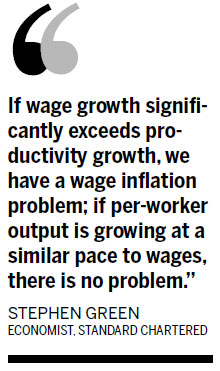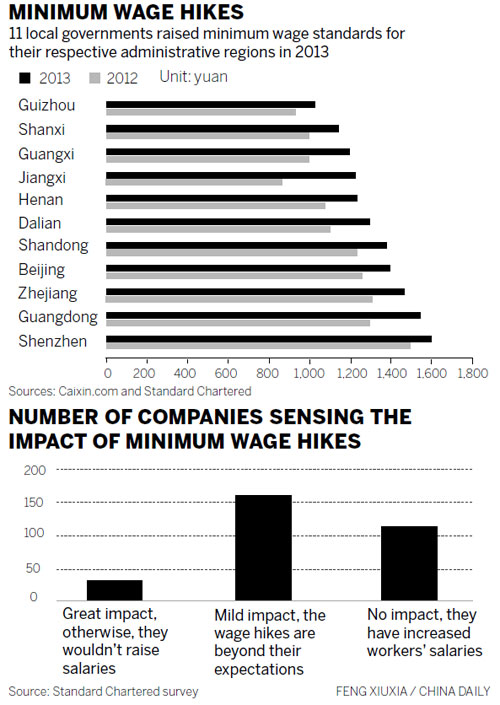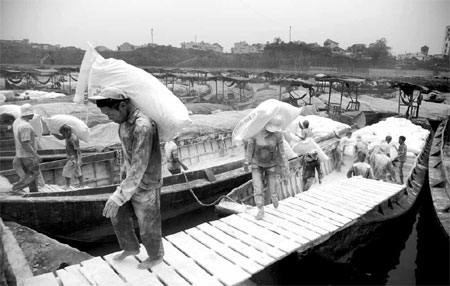Report: Wages on the rise
Updated: 2013-04-15 07:57
By Hu Yuanyuan (China Daily)
|
||||||||
|
Workers unloading goods imported from Vietnam at a dock in Dongxing city, South China's Guangxi Zhuang autonomous region. Around 75 percent of respondents expect wages to increase by as much as 10 percent this year, similar to 2012, said Standard Chartered in its latest report. Provided to China Daily |

Manufacturing wages in southern China's Pearl River Delta are expected to rise 9.2 percent this year, faster than the 7.6 percent rate of growth respondents reported for 2012 wages, Standard Chartered said in a report.
"The rise is partly policy-induced and partly a reflection of labor shortages," said Stephen Green, an economist with Standard Chartered.
Nearly 63 percent of respondents say minimum wage hikes have had at least some impact on the wages they pay, while 88 percent believe the current labor shortage is at least as bad as last year. Additional pressure is coming from stricter enforcement of companies' social insurance payments and wage negotiations with labor representatives, the report said.
Higher productivity helps to explain and absorb higher wages, according to the survey. The majority of companies say that output per worker has risen faster than wages, a fact they see as a positive sign.
When asked how companies are responding to labor shortages, a larger share of respondents than last year said they plan to relocate their factories by either moving inland or leaving China, but the majority still aim to boost capital investment to save on labor costs. Beyond wages, orders appear to be improving, and yuan appreciation expectations are back.
It was the fourth annual survey of its kind conducted by Standard Chartered in February after the Lunar New Year holiday. It received a record number of responses - 302, versus 204 last year - from manufacturers operating in the Pearl River Delta.
Labor shortages
Around 75 percent of respondents expect wages to increase by as much as 10 percent this year, similar to 2012.
However, wage pressures have clearly increased over the past 12 months. The latest survey showed a significant decline in those expecting no wage hikes this year and an increase in those expecting increases of more than 10 percent.
Average expectations are for a 9.2 percent increase for 2013, versus 7.6 percent in 2012. With official consumer price index inflation expected to rise to 4 percent in 2013, according to a Standard Chartered forecast, from 2.6 percent last year, real wages should rise at about the same pace. Of 302 respondents, 180 (60 percent) said they have already raised wages this year, by an average of 7.9 percent.
Only 36 respondents (12 percent) find it less difficult to find workers now than at this time last year. A total of 34 percent of respondents believe labor shortages have worsened since 2011, similar to last year's 35 percent
"Both results support our long-held view that there were no material job losses during last year's slowdown," said Green.
As the survey shows, 83 percent of surveyed companies are operating at 80 percent or more of their full workforce.
Survival game
A running theme across the bank's surveys over the years is that higher wages reflect and are generated by higher rates of labor productivity.
"If wage growth significantly exceeds productivity growth, we have a wage inflation problem; if per-worker output is growing at a similar pace to wages, there is no problem," said Green.
Around 8 percent of respondents believe that their per-worker output has risen more than wages. But, like last year, a large minority reported otherwise.
"This means that we should still expect some of the increase in wage costs to spill over into prices of final goods, broadening inflationary pressures. Some companies are clearly more constrained than others when it comes to increasing productivity," Green added.
Companies are investing in capital equipment - 184 (61 percent) of respondents said this was their primary response to labor shortages. Process automation and streamlining, outsourcing or partially sub-contracting production, boosting in-house design functions and using employment agencies are some of the other responses cited.
Threshold value
The 12th Five-Year Plan (2011-15) sets a goal of raising the national minimum wage by an average of at least 13 percent a year, faster than in past years.
Localities are free to set their wages above the national level.
"Our working hypothesis has been that real labor-market changes have driven wages higher and that minimum wages have generally lagged," said Green.
In this survey, only 31 (10 percent) of 302 respondents considered minimum wage increases to have had a "huge" impact.
However, just over half said that the hikes have forced them to raise wages more than they had planned. The bank's survey had the same results in 2012, suggesting that minimum wage hikes have had a significant cumulative effect, particularly on the least-skilled part of the workforce.
"We note, though, that 103 (37 percent) respondents think their wages would have risen even without the hike in the required minimum," said Green.
A total of 11 provinces and cities have already announced minimum wage hikes this year. The average increase has been about 16 percent. Shenzhen has the highest wages for migrant workers in the country at 1,600 yuan a month. According to the Ministry of Human Resources and Social Security, a total of 25 provinces adjusted their minimum wages last year by an average of 20.2 percent.
huyuanyuan@chinadaily.com.cn

(China Daily 04/15/2013 page14)

 In Photos: 7.0-magnitude quake hits Sichuan
In Photos: 7.0-magnitude quake hits Sichuan
 Li Na on Time cover, makes influential 100 list
Li Na on Time cover, makes influential 100 list
 FBI releases photos of 2 Boston bombings suspects
FBI releases photos of 2 Boston bombings suspects
 World's wackiest hairstyles
World's wackiest hairstyles
 Sandstorms strike Northwest China
Sandstorms strike Northwest China
 Never-seen photos of Madonna on display
Never-seen photos of Madonna on display
 H7N9 outbreak linked to waterfowl migration
H7N9 outbreak linked to waterfowl migration
 Dozens feared dead in Texas plant blast
Dozens feared dead in Texas plant blast
Most Viewed
Editor's Picks

|

|

|

|

|

|
Today's Top News
Live report: 7.0-magnitude quake hits Sichuan, heavy casualties feared
Boston suspect cornered on boat
Cross-talk artist helps to spread the word
'Green' awareness levels drop in Beijing
Palace Museum spruces up
First couple on Time's list of most influential
H7N9 flu transmission studied
Trading channels 'need to broaden'
US Weekly

|

|








